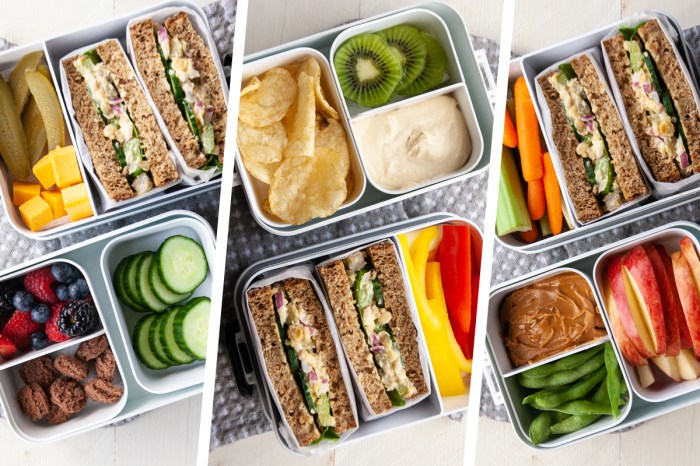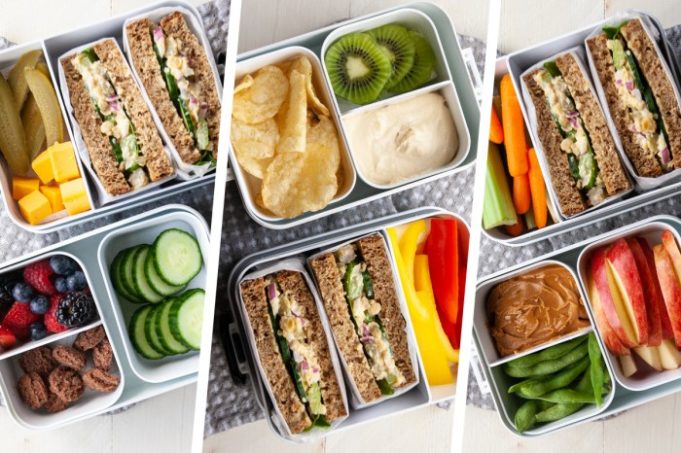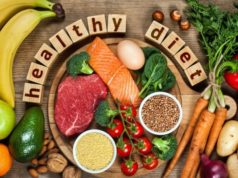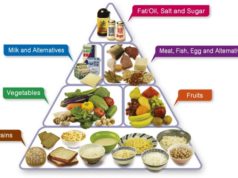Ideas for diet lunch are everywhere, but finding healthy and delicious options that fit your lifestyle can be challenging. Whether you’re trying to lose weight, manage a health condition, or simply eat better, this guide offers a range of lunch ideas to help you achieve your goals. From quick and easy recipes to budget-friendly options and tips for packing a nutritious lunch on the go, we’ll explore a variety of strategies to make healthy eating enjoyable and sustainable.
We’ll delve into the importance of balanced meals and essential macronutrients, providing tips for incorporating various food groups into your lunch. We’ll also discuss how to create lunchtime variety with diverse ingredients and flavors, and explore options for specific dietary needs. So, get ready to discover a world of delicious and nutritious lunch possibilities!
Healthy Lunch Basics

A balanced lunch is crucial for providing your body with the energy and nutrients it needs to power through the afternoon. It helps maintain stable blood sugar levels, prevents energy crashes, and supports overall health and well-being.
Macronutrients in a Healthy Lunch
Macronutrients are essential components of a healthy diet, and each plays a unique role in providing energy and supporting various bodily functions.
- Protein: Protein is essential for building and repairing tissues, producing enzymes and hormones, and maintaining a healthy immune system. Good sources of protein for lunch include lean meats, poultry, fish, beans, lentils, tofu, and eggs.
- Carbohydrates: Carbohydrates are the body’s primary source of energy. They provide fuel for physical activity and brain function. Choose complex carbohydrates, such as whole grains, fruits, and vegetables, over refined carbohydrates like white bread and sugary drinks.
- Fats: Fats are essential for hormone production, cell function, and absorbing certain vitamins. Include healthy fats in your lunch, such as those found in avocados, nuts, seeds, and olive oil. Limit saturated and trans fats, which can increase the risk of heart disease.
Incorporating Food Groups into Lunch
A well-rounded lunch should include a variety of food groups to ensure you get a diverse range of nutrients.
- Fruits: Fruits are rich in vitamins, minerals, and fiber. They provide natural sweetness and antioxidants. Aim for at least one serving of fruit in your lunch, such as a piece of fruit, a fruit salad, or a smoothie.
- Vegetables: Vegetables are packed with essential vitamins, minerals, and fiber. They can be enjoyed raw, cooked, or as part of a salad. Include a variety of colors in your lunch to get a wide range of nutrients.
- Grains: Choose whole grains over refined grains, which are higher in fiber and nutrients. Examples of whole grains include brown rice, quinoa, oats, and whole-wheat bread.
- Protein Sources: Protein sources provide essential amino acids, which are building blocks for tissues and cells. Choose lean protein sources, such as fish, poultry, beans, lentils, tofu, and eggs.
Quick & Easy Lunch Ideas
Lunchtime doesn’t have to be a stressful rush. With a little planning and some creative ideas, you can enjoy healthy and delicious meals that are quick and easy to prepare. Whether you’re short on time or simply want to simplify your lunch routine, these recipes and tips will help you create satisfying lunches that fuel your body and mind.
Quick & Easy Lunch Recipes
These recipes are designed to be prepared in under 30 minutes, making them perfect for busy weekdays.
| Meal Type | Recipe Name | Ingredients | Preparation Time |
|---|---|---|---|
| Salad | Mediterranean Quinoa Salad | Quinoa, chopped cucumber, cherry tomatoes, red onion, feta cheese, Kalamata olives, lemon juice, olive oil, salt, pepper | 20 minutes |
| Sandwich | Avocado & Hummus Wrap | Whole wheat tortilla, mashed avocado, hummus, spinach, sprouts, sliced bell pepper | 15 minutes |
| Soup | Lentil Soup | Lentils, vegetable broth, carrots, celery, onion, garlic, cumin, turmeric, salt, pepper | 25 minutes |
| Pasta | Pesto Pasta Salad | Cooked pasta, pesto, cherry tomatoes, mozzarella balls, fresh basil, olive oil, salt, pepper | 15 minutes |
| Snack | Trail Mix | Almonds, walnuts, cashews, dried cranberries, raisins, sunflower seeds, pumpkin seeds | 5 minutes |
Lunch Ideas Using Leftovers
Transforming dinner leftovers into a satisfying lunch is a great way to reduce food waste and save time. Here are three ideas:
“Leftovers can be just as delicious as a freshly prepared meal. Get creative and explore new flavor combinations.”
- Chicken Salad Sandwich: Use leftover roasted chicken, combine it with mayonnaise, celery, and grapes. Serve on whole wheat bread.
- Taco Salad: Combine leftover taco meat, shredded cheese, lettuce, tomatoes, and sour cream in a bowl. Top with your favorite taco toppings.
- Pasta Frittata: Use leftover cooked pasta and combine it with eggs, cheese, and vegetables. Bake in the oven until set.
Lunch on the Go: Ideas For Diet Lunch
Eating healthy while on the go can be a challenge. Between work, errands, and social commitments, it can be tempting to grab fast food or skip meals altogether. However, with a little planning, it’s possible to enjoy nutritious and satisfying lunches even when you’re busy.
Packing a Healthy Lunch, Ideas for diet lunch
Packing a healthy lunch is a great way to ensure you get the nutrients you need, even when you’re on the go. Here are some tips for packing a lunch that stays fresh and appealing:
- Use insulated lunch bags or containers to keep food cold or warm.
- Pack foods that are easy to eat on the go, such as sandwiches, salads, or wraps.
- Choose healthy snacks to keep you satisfied between meals.
- Consider packing a reusable water bottle to stay hydrated throughout the day.
Lunchbox Ideas
Here are three lunchbox ideas with healthy snacks and a main dish:
Lunchbox Idea 1:
- Main Dish: Quinoa salad with grilled chicken, black beans, corn, and avocado
- Snacks: A handful of almonds and a piece of fruit, such as an apple or banana
Lunchbox Idea 2:
- Main Dish: Turkey and avocado wrap with spinach and tomato
- Snacks: Carrot sticks with hummus and a small container of Greek yogurt
Lunchbox Idea 3:
- Main Dish: Leftover lentil soup with a whole-wheat roll
- Snacks: A small bag of trail mix and a piece of dark chocolate
Lunchtime Variety
Eating the same lunch every day can get monotonous, and it’s not the best for your health. Introducing a variety of flavors and ingredients into your lunch routine is key to keeping your meals exciting and nutritious.
Planning a diet lunch doesn’t have to be a chore. There are tons of delicious and healthy options that can keep you feeling satisfied until dinner. If you’re looking for some inspiration, check out if diet for a wealth of ideas and tips on how to make healthy eating a breeze.
From protein-packed salads to veggie-filled wraps, there’s something for everyone!
Adding variety to your lunch can help you consume a wider range of nutrients, reduce boredom, and encourage you to try new things. This can be as simple as switching up your protein source or adding a new veggie to your salad.
Finding healthy and satisfying lunch options can be a challenge, especially when trying to stick to a specific diet. If you’re on the keto diet, you might wonder can you drink diet soda on keto , as it’s often considered a low-carb beverage.
While it’s generally acceptable in moderation, remember to focus on nutrient-rich foods for a balanced and effective keto lunch.
Lunch Recipes from Around the World
Exploring different cuisines can introduce you to a world of flavors and textures. Here are a few lunch recipes from various cultures to inspire your culinary adventures:
- Mediterranean: A vibrant and flavorful Greek Salad with Kalamata olives, feta cheese, cucumbers, tomatoes, red onion, and a tangy lemon vinaigrette.
- Asian: A quick and easy stir-fry with tofu, vegetables like broccoli, carrots, and bell peppers, and a savory soy sauce-based sauce.
- Mexican: A hearty and satisfying burrito bowl filled with brown rice, black beans, corn, salsa, guacamole, and your choice of protein like chicken or tofu.
- Indian: A flavorful lentil soup (dal) with aromatic spices like cumin, turmeric, and coriander, served with a dollop of yogurt and a side of rice.
- Italian: A classic Caprese salad with fresh mozzarella, juicy tomatoes, and fragrant basil leaves drizzled with olive oil and balsamic vinegar.
Seasonal Lunch Recipes
Taking advantage of seasonal produce is a great way to enjoy the freshest flavors and support local farmers. Here are some ideas for incorporating seasonal ingredients into your lunch:
- Summer: A refreshing gazpacho soup made with ripe tomatoes, cucumbers, bell peppers, and a touch of garlic.
- Fall: A warm and comforting butternut squash soup with a dollop of Greek yogurt and a sprinkle of pumpkin seeds.
- Winter: A hearty winter salad with roasted root vegetables like beets, sweet potatoes, and parsnips, tossed with a tangy vinaigrette.
- Spring: A vibrant spring salad with fresh asparagus, peas, and strawberries, dressed with a light vinaigrette.
Budget-Friendly Lunch Options
Packing a healthy lunch doesn’t have to break the bank. With a little planning and creativity, you can enjoy delicious and nutritious meals without sacrificing your budget.
Tips for Affordable and Healthy Lunches
Saving money on lunches often means embracing a few smart strategies. Here are some tips to help you prepare affordable and healthy lunches:
- Plan ahead: Meal planning is key to saving money. By planning your lunches for the week, you can avoid impulse purchases and ensure you have all the ingredients on hand.
- Buy in bulk: Stock up on staples like rice, beans, lentils, and canned goods. These items are often cheaper in bulk and can be used in various recipes.
- Cook in larger batches: Prepare extra food when you cook dinner and pack the leftovers for lunch. This saves time and money, and you can easily create multiple lunches from one meal.
- Take advantage of sales: Keep an eye out for weekly sales and stock up on discounted items. This can help you save money on fresh produce, protein, and other lunch essentials.
- Embrace seasonal produce: Seasonal fruits and vegetables are typically cheaper and tastier. Plan your meals around what’s in season to maximize savings.
- Cook at home: Making your own lunches can save you a significant amount of money compared to buying pre-made meals.
Budget-Friendly Lunch Recipes
These recipes use inexpensive ingredients and are easy to prepare:
Black Bean and Corn Salad
This salad is a great source of protein and fiber.
- 1 can (15 ounces) black beans, rinsed and drained
- 1 cup frozen corn, thawed
- 1/2 red onion, diced
- 1/4 cup chopped cilantro
- 1/4 cup lime juice
- 2 tablespoons olive oil
- Salt and pepper to taste
Combine all ingredients in a bowl and toss to coat. Serve chilled.
Tuna Salad Sandwiches
This classic lunch is affordable and easy to customize.
- 2 cans (5 ounces each) tuna in water, drained
- 1/2 cup mayonnaise
- 1/4 cup chopped celery
- 1/4 cup chopped onion
- 1 tablespoon Dijon mustard
- Salt and pepper to taste
- 2 slices whole-wheat bread
Combine the tuna, mayonnaise, celery, onion, mustard, salt, and pepper in a bowl. Spread the tuna salad on the bread slices and enjoy.
Lentil Soup
This hearty soup is packed with protein and fiber and is perfect for a cold day.
- 1 cup dried lentils, rinsed
- 4 cups vegetable broth
- 1 onion, chopped
- 2 carrots, chopped
- 2 celery stalks, chopped
- 2 cloves garlic, minced
- 1 teaspoon dried thyme
- 1 bay leaf
- Salt and pepper to taste
In a large pot, combine all ingredients. Bring to a boil, then reduce heat and simmer for 30 minutes, or until the lentils are tender. Remove the bay leaf before serving.
Meal Prepping Strategies
Meal prepping can save you time and money in the long run. Here are some tips for successful meal prepping:
- Choose recipes that are easy to make in bulk: Look for recipes that can be easily doubled or tripled, such as salads, soups, or grain bowls.
- Prepare ingredients in advance: Chop vegetables, cook grains, and measure out ingredients on the weekend to save time during the week.
- Store meals in individual containers: This makes it easy to grab and go in the morning.
- Label and date your meals: This helps you stay organized and ensures you eat your meals before they expire.
Summary
Ultimately, the key to enjoying healthy lunches lies in finding options that are both satisfying and convenient. By embracing the tips and recipes presented in this guide, you can create a lunch routine that nourishes your body and supports your overall well-being. Remember, healthy eating is a journey, not a destination, so be kind to yourself, experiment with different ideas, and most importantly, enjoy the process!
FAQ Section
What are some good sources of protein for lunch?
Good sources of protein for lunch include lean meats, poultry, fish, beans, lentils, tofu, eggs, and nuts.
How can I make my lunch more exciting?
Try incorporating diverse flavors and textures by adding herbs, spices, sauces, and different types of vegetables.
What are some tips for packing a healthy lunchbox?
Pack a variety of foods, including a protein source, healthy carbohydrates, and fruits or vegetables. Choose reusable containers and pack snacks to keep you full and energized throughout the day.
Is it okay to eat leftovers for lunch?
Absolutely! Leftovers can be a great way to save time and money. Just be sure to store them properly and reheat them thoroughly.
Coming up with diet-friendly lunch ideas can be a challenge, especially when you’re trying to stay on track with your health goals. If you’re looking for a structured approach to healthy eating, consider a clean diet plan , which emphasizes whole, unprocessed foods.
This type of plan can provide valuable guidance for creating satisfying and nutritious lunches that support your overall well-being.
























